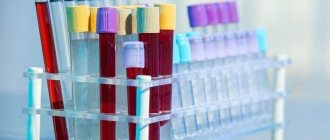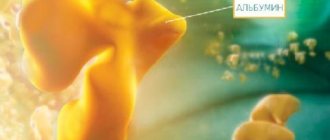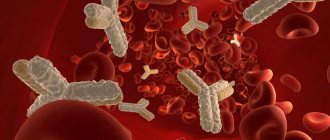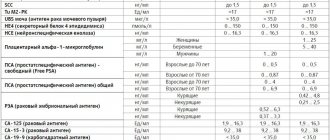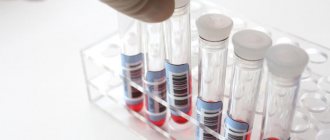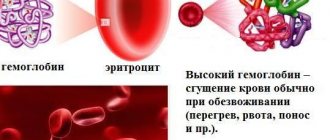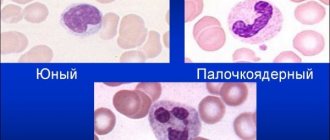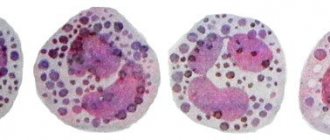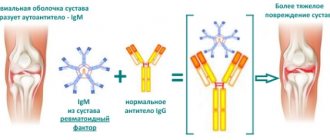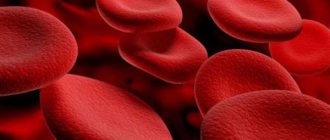What is tumor marker S100? It is a protein that can bind calcium. This protein is found in large quantities in skin cells and is also present in the brain and spinal cord.
Remember! Samples can be taken using different methods, so their results cannot be compared - the interpretation may be incorrect.
Tumor marker functions
The tumor marker received its name as a result of its ability to dissolve in ammonium sulfate at normal pH. The antigens of this tumor marker perform various functions and take part in various physiological processes.
The s100 level shows the presence or absence of melanoma, serves as an indicator of “breakdowns” in the central nervous system, and indicates various neoplastic diseases and inflammations. To diagnose brain damage, the forms of the protein are determined - tumor marker s100 (pp) or c100 (of). They are used as markers of possible damage to brain tissue due to circulatory disorders in the brain. In case of cerebral hemorrhages, the maximum concentration in the blood can be determined on the first day, in case of ischemic stroke - on the third day.
Increasing values
Oncological pathologies:
- melanoma;
- mammary cancer;
- lungs' cancer;
- stomach cancer;
- pancreas cancer;
- bladder cancer;
- prostate cancer;
- ovarian cancer;
Neurological disorders:
- damage to brain tissue caused by metabolic disorders, hypoglycemia or trauma;
- spontaneous subarachnoid bleeding;
- Alzheimer's disease;
- ischemic stroke;
Heart diseases:
- myocardial hypertrophy;
- acute ischemia (heart attack);
Inflammatory and autoimmune diseases:
- systemic lupus erythematosus;
- rheumatoid arthritis;
- psoriasis;
Other diseases:
- hepatic encephalopathy – neuromuscular and mental disorders associated with chronic liver failure;
- multiple (multiple) sclerosis – severe damage to the central nervous system, occurs in young and middle age;
- exacerbation of manic-depressive psychosis;
- consequences of clinical death and subsequent resuscitation of the patient.
In the presence of asphyxia of newborns, a high S 100 indicator indicates ischemic encephalopathy.
Oncology: melanoma
To make a primary diagnosis, a test for protein S 100B is not advisable, since only the 2nd, 3rd and 4th stages of melanoma are characterized by a persistent increase in the tumor marker, the level of which is directly proportional to the stage and progression of the disease. This property is actively used in predicting the risks of metastasis and relapse of the disease.
Monitoring the condition of patients with diagnosed melanoma reflects the main features of the clinical course of the oncological process. In this case, excess of the protein S 100B norm is recorded in patients:
- without severe symptoms – in 5.5%;
- with regional metastases – in 12.5%;
- with metastases in the skin/lymph nodes – 47.6%;
- with distant/visceral metastases – in 42.9% of cases.
The remaining S 100 protein dimers are used in the diagnosis of other types of oncology:
- S 100(A4) – cancer of the lungs, breast, stomach, pancreas, bladder;
- S 100(A7) – cancer of the lung, ovary;
- S 100(A9) – differential diagnosis of prostate cancer and benign prostatic hyperplasia, etc.
Serum levels of S100 proteins can be used as an accurate diagnostic and prognostic marker in patients with suspected or already diagnosed colorectal neoplasia. Colorectal cancer is the third most common cancer in men (after lung and prostate cancer) and the second most common cancer in women (after breast cancer) worldwide.
Brain damage
An increase in the level of protein S 100 in the cerebrospinal fluid and its subsequent release into the bloodstream is recorded in neurological disorders of various etiologies (trauma, stroke, hypoxia, hypoglycemia, etc.).
Ischemic stroke is characterized by an increase in the values of this marker in the first 8 hours and maintaining the level in the first 3 days after the attack. Moreover, the larger the area of damage to brain tissue and the more severe the consequences, the higher the concentration of protein S 100B.
The severity of subarachnoid bleeding is also assessed based on the test results - a marker level of more than 0.3 μg/l indicates an unfavorable course and outcome of the disease.
Damage to brain tissue as a result of trauma is accompanied by an increase in protein S 100 values both in the blood serum and in the cerebrospinal fluid.
Diagnostic value of the S 100 protein test for brain injuries:
- sensitivity – 96.5-100%;
- specificity – 30-35%.
That is, in almost all patients out of 100, this tumor marker in the blood will be higher than normal. Moreover, in 70% of cases the test will give a false positive result, i.e. erroneously detected in healthy people.
Only in some cases of traumatic brain injury do the test results require confirmation by tomographic examination. Negative test results indicate with 100% certainty that there is no brain damage.
In patients with moderate damage to brain tissue without significant cognitive impairment, exceeding the threshold values of protein S 100 is observed in 31-48% of cases (depending on the subtype of protein). In such situations, the results obtained cannot be considered predictive, especially in pediatric practice.
In emergency situations (cardiac arrest) after successful resuscitation, an increase in S 100 level of more than 1.5 μg/l signals the development of severe neurological complications.
Autoimmune cardiovascular diseases
In patients suffering from systemic lupus erythematosus complicated by neurological disorders, this protein is also elevated.
Some S 100 protein dimers may indicate myocardial pathologies, since they participate in the contraction of the heart muscle, or inflammatory processes (bronchitis, rheumatoid arthritis, cystic fibrosis), since they are secreted by phagocytes and take part in the body’s immune response to inflammation. In patients with acute myocardial infarction, there is an increase in the level of S-100A1 in the blood.
Important! The interpretation of the results is always carried out comprehensively. It is impossible to make an accurate diagnosis based on only one analysis.
Leading clinics in Israel
Assuta
Israel, Tel Aviv
Ikhilov
Israel, Tel Aviv
Hadassah
Israel, Jerusalem
Where is it formed
This brain-specific protein can be found in various tissues of the human body. The formation of S 100 occurs in cells of various types, for example:
- Lymph node cells;
- Melanocytes (have neutral origin, produce melanin);
- Chondrocytes (components of cartilage);
- Adipocytes (produce adipose tissue - protein S100b);
- Lemmocytes (participate in the process of creating the myelin sheath of neurons);
- Neuroglia (perform protective, support functions, surrounding neurons and capillaries);
- Myoepithelial (one of the components of the exocrine glands);
- Pacinian corpuscles (nerve receptors in the skin that are responsible for the perception of touch and vibration);
- Langerhans cells (components of the skin's immune system).
Summary, or Briefly about the main thing
Tumor markers are useless in the primary diagnosis of melanoma and skin cancer.
Moreover, I strongly do not recommend taking them as the only method of examination, since with a false positive result, neurosis may develop. Tumor markers S-100, LDH and SCCA are currently used very limitedly in dermato-oncology .
Other articles:
- Frequently asked questions: what you can and cannot do before and after mole removal
- Shaving, hair removal and tattoos if you have moles
- Why is it important to detect melanoma at an early stage?
- Many moles on the body - how many?
Useful article? Repost on your social network!
Combinations for testing for oncology
The antigen of this protein is a homo- and heterodimer of α or β in three combinations:
- αα – in striated muscles, kidneys, heart, liver;
- αβ – melanocytes;
- ββ – in glial and Schwann cells.
The doctor himself determines the option required for the test. This blood test is performed to diagnose and monitor the outcome of treatment for cancer, neurological diseases and diseases of a neurological nature. s100 is the only tumor marker susceptible to melanoma. Testing for this antigen is also necessary if you have unfavorable heredity for types of cancer that can be detected by this tumor marker.
What to do if you have tested the tumor markers S-100, SCC and they are positive?
Unfortunately, you will need to undergo a fairly in-depth examination, otherwise you will most likely not be able to relax. A FULL examination of all skin by an oncologist-dermatologist is required, including dermatoscopy of all moles on the body, clinical and biochemical tests of blood, urine, ultrasound of the abdominal cavity and all groups of lymph nodes, pelvis, and chest x-ray.
If positive tumor markers are detected, a full diagnosis will be required
When are tests needed?
Testing for this protein is required in the following areas of medicine when various diseases are suspected:
- Oncology. This tumor marker is needed for the timely detection of melanoma metastases, disease relapses, malignant transformations of other organs and to assess the success of skin cancer treatment;
- Cardiology. S100 is required for angina pectoris and all kinds of heart rhythm disturbances;
- Neurology. Analysis of the s100 protein is needed if Alzheimer's disease is suspected (in elderly patients) and asphyxia in newborns;
- Rheumatology. The analysis is necessary for autoimmune diseases - rheumatoid arthritis, Libman-Sachs disease;
- Traumatology. As a clarifying examination for head injuries.
Indications
The study is prescribed and its results are interpreted by specialized specialists: oncologist, cardiologist, neurologist, rheumatologist.
- Diagnosis, monitoring the effectiveness of treatment and predicting the outcome of oncological, neurological, inflammatory and other diseases.
The S 100 biomarker test is used in the following areas of medicine:
- oncology – diagnosis of melanoma (not for making a primary diagnosis, but for monitoring the course, early detection of relapses and metastases), as well as some other malignant neoplasms;
- neurology – diagnosis and monitoring of traumatic brain injury, newborn asphyxia, Alzheimer’s disease;
- cardiology – diagnosis of acute ischemia, heart failure;
- rheumatology – diagnosis and treatment of rheumatoid arthritis, systemic lupus erythematosus, psoriasis, etc.
What diseases change s100 indicators
Since the s100 onomarker shows the level of protein, its increase can signal various human diseases. It can be:
- Malignant transformation of tumors into cancer (melanoma, lesions of the lung, bladder, breast, ovary);
- Nervous system disorders (Charcot's disease, Alzheimer's disease, Down syndrome, multiple sclerosis, neurodegeneration, spastic pseudosclerosis);
- Autoimmune and inflammatory disorders (psoriasis, chronic bronchitis, rheumatoid arthritis);
- Heart disease (heart failure, ventricular hypertrophy).
Also, an increase in protein concentration can be observed in people who have undergone surgery under artificial circulation.
Decreased protein levels may also be diagnosed. This happens when:
- Reduction (or complete disappearance) of a cancerous tumor during treatment;
- Severe heart failure.
An elevated level of a tumor marker may indicate other complex diseases or abnormal conditions in a person. If you receive an analysis with an increased level of protein, it is recommended to take it again to exclude a false result, and conduct the necessary additional studies. All this is necessary to establish an accurate diagnosis.
Remember! The concentration of s100 becomes higher with age, and this happens more often in men than in women. To confirm the accuracy of the analysis, it is repeated and tomography is performed.
Pathologies leading to increased protein
An increase in protein S-100 can indicate several types of pathology, and its concentration indicates the activity of the process. When the amount of marker in the blood may increase:
- malignant skin tumors, including melanoma,
- functional disorders of the brain of a traumatic nature,
- degenerative changes in brain neurons (Alzheimer's disease),
- subarachnoid hemorrhage, stroke,
- neuromuscular disorders resulting from severe liver failure,
- some mental disorders caused by brain disorders,
- myocardial infarction,
- some inflammatory diseases.
As you can see, the detection of the S-100 marker does not always indicate the development of a tumor process; often its appearance helps to detect disturbances in the functioning of the brain even before the appearance of the first obvious signs and begin treatment on time.
Preparation for analysis
To donate blood from a vein for the s100 tumor marker, it is necessary to carry out preliminary preparation of the body. A couple of days before donating blood, eliminate fatty foods from your diet. 8 hours before donating blood, you should not eat, drink tea, coffee, or carbonated drinks. Before taking the test, do not strain your body with physical activity (this can increase the level of s100 protein). Half an hour before the test, do not smoke. Immediately before donating blood, you need to rest for 15-20 minutes. If you are taking any medications, you must inform your doctor; this also applies to all kinds of medical procedures.
S100 protein is a marker associated with malignant melanoma
Malignant melanoma is one of the most aggressive types of skin cancer. The tumor develops from melanocytes - cells that produce melanin (pigment). These cells produce the S100 protein, which is used as a marker for tumor transformation of melanocytes.
For a favorable prognosis of this disease, early diagnosis of the primary tumor is critical. Early detection of metastases and relapses of the disease is also extremely important.
S100 protein is the only sensitive serological marker for melanoma. With adequate therapy and successful surgery, the content of this protein decreases. In patients suffering from malignant melanoma, especially in stages II, III and IV, an increase in the level of S100 in the blood may characterize the progression of the disease. This is an important fact in monitoring such patients and predicting the course of the disease.
Decoding the results
For such a study, cerebrospinal fluid is taken, sometimes cerebrospinal fluid or blood from a vein - in most cases. The normal level of protein is considered to be a concentration of no higher than 0.105 μg/l. If cerebrospinal fluid was collected, then the concentration considered normal will be no higher than 5 μg/l. If the level is higher, this is considered a pathology.
But almost 100% proof of a tumor process is a fivefold or more increase in the level of s100. If the indicators are higher than normal, but not very much, this may indicate diseases of another origin. But an accurate diagnosis is made on the basis of other tests, and not just this tumor marker. Therefore, the patient needs to undergo additional examinations.
Norm and reasons for increasing tumor marker concentrations
The normal concentration of the S100 marker is up to 0.105 ng/ml, in the cerebrospinal fluid (cerebrospinal fluid) - up to 5 ng/ml. Reference values in a separate laboratory may differ slightly from those indicated - this depends on the sensitivity and specifics of the test.
An increase in S100 concentration may be due to such tumor diseases as:
- melanoma;
- malignant neoplasms in nervous tissue;
- breast carcinoma;
- liposarcoma and lipoma;
- coracinoid;
- neoplasia of the salivary glands and skin appendages.
As a rule, in the first stages of cancer, the level of the tumor marker increases slightly (no more than 0.120 ng/ml in a very small proportion of clinical cases). With metastasis to regional and distant lymph nodes, as well as internal organs, the sensitivity of the antigen increases: in almost 50% of cases a dangerous level of protein is observed (more than 0.5 ng/ml).
Changes in s100 levels in melanoma
With non-cancerous formations on the skin and in completely healthy people, normal levels of s100 are observed. While people with stage II melanoma have 1.3% higher levels of this protein, those with stage III melanoma will have 8.7% higher protein levels. The fourth stage of melanoma will show an excess of protein levels by 73.9%. As the tumor grows, fluctuations in protein concentration will increase in proportion to the change in tumor size.
In patients with the initial stage of melanoma, the level of the s100 tumor marker will exceed normal by 5.5%; if there is metastasis to neighboring organs, then the increase will be by 12%; distant metastases will increase the s100 indicators by 43-47 percent.
After confirmation of the diagnosis, analysis of this tumor marker is carried out to see progress in treatment, the degree of regression of skin cancer and to determine the patient’s condition.
Why can’t you donate tumor markers “just for prevention”?
Because the result of these tests, if prescribed unjustifiably, very often be unreliable. There are 2 options:
1) False positive result - the test says that there is cancer, but in fact it is not. The person begins to be frantically examined, nothing is found anywhere, and a real neurosis develops.
2) False negative - the test says that there is no cancer, but there is. It’s even worse here: instead of adequate examinations, a person calms down and grows the tumor until the later stages, when treatment is no longer effective.
Changes in s100 levels during the operation of other body systems
An increase in the level of tumor marker s100 can be observed not only in the presence of tumor diseases, but also in other diseases. An increase in s100 to 0.4 μg/l can be observed in some diseases of the genitourinary system, lungs, and gastrointestinal tract. An increase in the s100 level to 2 μg/l also occurs with severe bacterial infections. In case of malfunctions in the central nervous system, it is also recommended to study the level of this protein to assess the level of disturbances in the functioning of the central nervous system and draw up a treatment plan.
General Protein Information and Analysis Importance
Brain-specific protein S100 – what is it? This is a neurospecific protein that is present in most cells of nerve fibers and skin. For this reason, a test for the C100 tumor marker is carried out mainly for oncological lesions of the central nervous system and skin. This substance is contained in low concentrations in the blood, so its accurate indicators in oncology can only be obtained by performing an enzyme-linked immunosorbent assay.
Now let's take a closer look at what these substances are, called antibodies to the S100 protein. AT are protein structures that begin to be released by the body (in particular, the immune system) to fight foreign elements. These can be viruses, bacteria and fungi, as well as atypical cancer cells. That is why, when the level of the brain-specific protein S100 increases in the patient’s biological fluid, a corresponding level of antibodies is detected.
Diagnostic value of the test for C100
What does the S100 blood test mean? The study is carried out to detect antibodies to this tumor marker in the patient’s blood, as well as to determine its level as such.
Despite the accuracy and importance of the test, it is not the only diagnostic method. Instrumental procedures – CT, MRI, ultrasound, radiography – play a huge role in making the correct diagnosis. If there is doubt about the nature of the disease, a biopsy is performed.
But this does not mean that the test for the S100 tumor marker does not carry any information or value. On the contrary, it is thanks to its implementation that the doctor gets the opportunity to understand how to proceed further and in what direction to move in terms of subsequent research.
Thus, S100 is a tumor marker, a test for which is most often prescribed by oncologists, neurologists and dermatologists. But since these proteins tend to be distributed throughout other organs, the OM-C100 test can also be performed in other pathological conditions.
